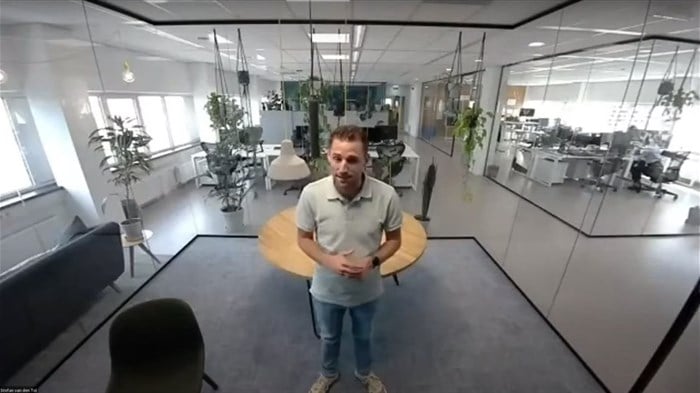During the second eLearning Indaba for 2022, hosted by New Leaf Technologies, Stefan van den Tol - chief customer officer of aNewSpring shared with us a seven step framework to ensure success when implementing a new learning platform.

Stefan van den Tol - chief customer officer of aNewSpring - source: eLearning Indaba on
YouTubeThe seven steps were as follows:
1. Desired outcomes and first value: Determine and define your goals to ensure your learning journey will have the desired impact. A vital question to answer here will be "What is it you are aiming to achieve?"
2. Implementation map: Van den Tol warns that "the switch to a blended learning solution can have quite an impact: your internal processes need to be reconsidered, stakeholders must be gathered, it will demand time, investments from you and potentially that of your colleagues.
"Before you start, it's important to think about those conditions. This gives you insight into your available resources and realistic planning. Think about your didactical model, the way you create content or how you keep your stakeholders connected. Make sure to always keep your desired outcome top of mind. They, together with your first value, are a guiding light in this implementation."
Within the implementation map, checklists will be used, resulting in actions. Some of these points can include target audience, types of learning activities, timeline, access to content, and necessary personnel involvement.
The most important thing is that everything you're doing aligns to your measures.
One critical point to contemplate in this step is how you are going to evaluate your courses at the end and when will they be considered a success? Success must be measurable, Van den Tol stresses.
3. Design: Creating a good design is crucial. Here you will design the learning journey with the aim to achieve your first values. Those questions listed in the implementation map will help guide the design.
However, Van den Tol says that "designing and building the learning journey should not be the goal, it should fill in the learning objectives."
4. Build: Only now will you actually build the learning journey based on the design created in step 3.
"It's a creative process and you can make it as fancy as you want, but the most important thing is to align your content with your learning objectives," Van den Tol reitereates.
"This is also the time to do the work," he continues. And by 'do the work', he means test the design and build. Take this opportunity to ensure that what you are building is actually functioning as and how it should. Fix anything that is broken or not working properly.
5. Launch: Before launching your course, conduct a final check. Do a walk-through of the course to ensure your learning objectives have been addressed by the activities you've built. Are there any open concerns when reflecting on your implementation map; are all the stakeholders on board? These questions should be answered before moving on to step 6.
6. Live: Your course is live and your first participants are signing up and engaging with your content.
"But learning doesn't always happen by itself," says Van den Tol. "Sometimes it needs a bit of guidance and help to come to fruition. In some cases, be sure to track the process and progress; anticipate your learners' knowledge gaps; and communicate with your learners. That can be the final step in making sure your course reaches its goals."
7. Measure: Here you will reflect on your first value, and ascertain whether you have you achieved your objectives.
"This will be so much easier when you define SMART [specific, measurable, achievable, realistic, and time-based] desired outcomes and first values," Van den Tol advises. "SMART goals like 90% knowledge retention or 95% of participants achieve their certificates can easily be checked off."
He recommends getting highly clinical when defining such goals, so that you can fully gauge what impact you are making on learners and your company.
How not to approach learning
During the session, Mike Hanly, MD of New Leaf Technologies, highlighted two big "don'ts" when it comes to online staff training programmes and onboarding.
Don't make your employees sit through lengthy virtual instructure-led training sessions with no interaction. This creates an environment where participants can check-in but switch off - cameras, mics - and leave the room. Meanwhile, the facilitator is teaching to the webcam without any engagement or feedback.
"There's no conversation, there's no knowledge retention or knowledge transfer taking place. And that is a trend I see all too often," says Hanly.
He recommends using available tools, such as a pre-quizz, beforehand to identify learner competency and knowledge shortfalls, which can then be used to tailor the virtual session to focus on the actual needs of the learner.
A similar approach of engagement should be taken when onboarding new hires. Onboarding done the right way can improve employee retention, shorten time to competency and rapidly increase performance, Hanly continues.
"One way to practically guarantee failure is to hand a newbie a pile of forms and manuals, start an orientation video in the office and just leave them be," he says. "Because when you come back, you'll probably find them surrounded by a couple of biscuit crumbs and a vague look of 'I've lost interest in this'."
Gamification, when used in the onboarding process, can be really impactful. Companies can tailor the onboarding process into a gamified learning journey, where new employees are tasked with challenges and activities related to the work they will be doing. Reward and recognition systems can be tied in to the new employee's progress. In this way, learner engagement is kept at a high level and recognition becomes a conversation point. What Hanly says they discovered with one particular client, is that employees who had been with the company for years wanted to be reinducted just to experience this learning journey and be able to earn the accolades that came with completing it.
View the full eLearning Indaba session below, featuring Stefan van den Tol, Chris Mathiopoulos of Epignosis, Mike and Paul Hanly and facilitated by Elan Ressel on behalf on New Leaf Technologies.









































